Irish Goodbye
New member
I am hoping to get some advice on what this could possibly be. I’ve been chasing the problem for the past few years, it comes up in many of my plants and I’ll be damned if I can sort out what is causing this. I’ve been through every damned nutrient deficiency table on the internet (which pretty much all seem to be the same thing cut and pasted) with no luck finding these grill marks.
The problem usually starts as slight blistering in the middle of the leaf that then progresses into fully open lesions or holes. This is not a bug, I repeat this is NOT a bug. I have inspected the tissue extremely thoroughly with a usb microscope. I am also fanatical with my IPM.
I almost always see this concurrently with these odd horizontal grill marks and general deformation of new growth. The leaf veins themselves become rusty and necrotic as well.
Symptoms are concentrated to the middle-lower foliage.
Medium is Promix HP/Coco Coir 50/50 mix. 2gal containers. Under 1000watt HPS, 32” from top of canopy. Temperatures are 77 lights on 68 lights off. Humidity right now is about 35-40% as I’m about to go into week 6 of flower, but these issues also happen in my veg room where my humidity runs about 60%.
Feeding GH Flora Series 3 part with 0.4EC of calmag added to RO water. Also using 1ml/gal of Potassium Silicate. Feed-water-water schedule at 2.0EC, ph 6.0.
Runoff EC hovers between 1.5-2.2 with a ph consistently around 5.6-6.2
The problem usually starts as slight blistering in the middle of the leaf that then progresses into fully open lesions or holes. This is not a bug, I repeat this is NOT a bug. I have inspected the tissue extremely thoroughly with a usb microscope. I am also fanatical with my IPM.
I almost always see this concurrently with these odd horizontal grill marks and general deformation of new growth. The leaf veins themselves become rusty and necrotic as well.
Symptoms are concentrated to the middle-lower foliage.
Medium is Promix HP/Coco Coir 50/50 mix. 2gal containers. Under 1000watt HPS, 32” from top of canopy. Temperatures are 77 lights on 68 lights off. Humidity right now is about 35-40% as I’m about to go into week 6 of flower, but these issues also happen in my veg room where my humidity runs about 60%.
Feeding GH Flora Series 3 part with 0.4EC of calmag added to RO water. Also using 1ml/gal of Potassium Silicate. Feed-water-water schedule at 2.0EC, ph 6.0.
Runoff EC hovers between 1.5-2.2 with a ph consistently around 5.6-6.2
Attachments
-
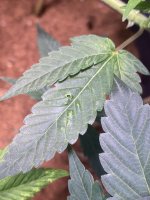 93675F39-53AD-42CA-A845-E763032C74BE.jpeg1.6 MB · Views: 48
93675F39-53AD-42CA-A845-E763032C74BE.jpeg1.6 MB · Views: 48 -
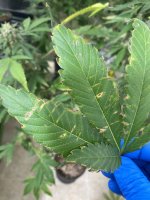 2924B01D-4E40-47D1-908B-21D90008D82B.jpeg932.3 KB · Views: 51
2924B01D-4E40-47D1-908B-21D90008D82B.jpeg932.3 KB · Views: 51 -
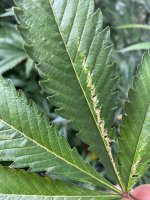 21A7DA66-12BD-4A00-8929-EEB44BECA652.jpeg2.2 MB · Views: 56
21A7DA66-12BD-4A00-8929-EEB44BECA652.jpeg2.2 MB · Views: 56 -
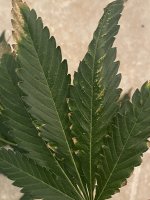 CB3104D6-DDB9-4023-AB41-71D9C97BCEC0.jpeg1.5 MB · Views: 54
CB3104D6-DDB9-4023-AB41-71D9C97BCEC0.jpeg1.5 MB · Views: 54 -
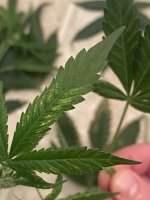 CB31AD4C-C121-4438-9AE0-A2574706E4DA.jpeg1.4 MB · Views: 63
CB31AD4C-C121-4438-9AE0-A2574706E4DA.jpeg1.4 MB · Views: 63 -
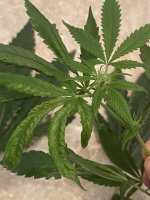 74DA2957-D605-470A-9A67-71F50FE9AEE7.jpeg1.3 MB · Views: 48
74DA2957-D605-470A-9A67-71F50FE9AEE7.jpeg1.3 MB · Views: 48 -
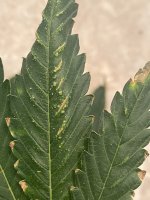 918D7CD4-3B6C-4937-9D4D-47A28D24B9F6.jpeg1.7 MB · Views: 55
918D7CD4-3B6C-4937-9D4D-47A28D24B9F6.jpeg1.7 MB · Views: 55




